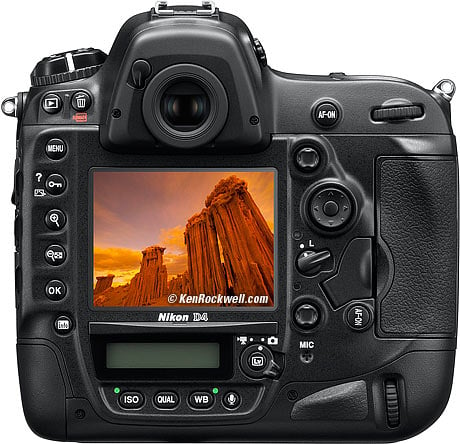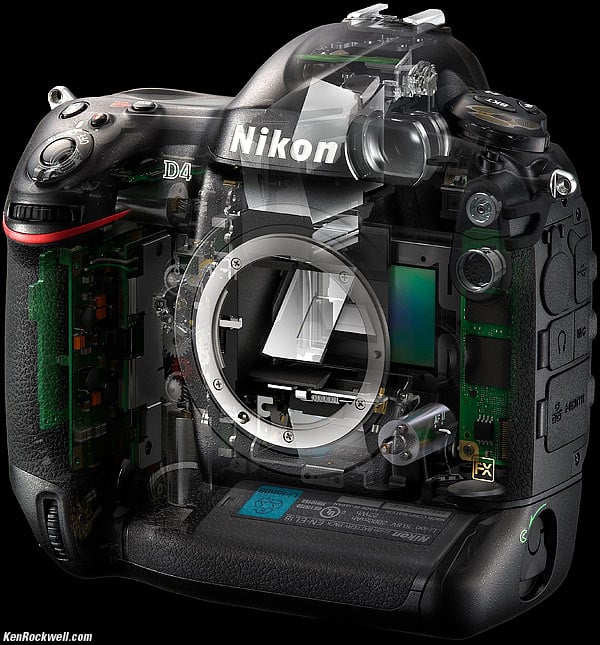 .
.
The Nikon D4 is an update to 2007's Nikon D3.
The new Nikon D4 offers slightly higher frame rates, slightly higher resolution, an updated AF system that works better with teleconverters, Kelvin white balance settings in 10K increments, a virtual horizon that finally works properly with both roll and pitch, much higher ISOs than the D3 and D3s, and wow, video.
The Nikon D4 is aimed at full-time professional news, sports and action photographers – or videographers shooting Canon DSLRs.
For landscape, nature and portrait and wedding photographers, theNikon D3x still has more resolution. For use in the field, the Nikon D7000 has the same resolution as the D4 with a lot less weight.
For most of us, the Nikon D4 is just a minor update to the D3, unless one of its features, like video or seeing in the dark at six-digit ISOs is a must-have for you. Otherwise, it's still the same camera as 1996's Nikon F5: there hasn't been any significant advance in basic ergonomics, shutter speeds, flash sync, metering or much of anything else for the past 16 years. (In fact, the Nikon F5's shutter goes all the way down to a timed 30 minutes all by itself, which I use and which no DSLR does.)
The D4 weighs about 3 ounces less than the D3, which is great news.
The D4 has only one CF card slot, and replaces the second with a slot for the new XQD cards. Great, now I have to buy new memory cards no one has ever seen just for backup!
Hallelujah, the buttons are now backlit, just like my 20-year old cell phone. The D4 also supposedly works with the good remote, the $15 ML-L3, and lets you have the camera vary its auto ISO shutter speed with focal length.
If you're a full-time pro, all these little things add up to make getting a couple of these a no-brainer. If you're not full time and the price of a new camera matters, then no, the D4 is nowhere near as innovatice as the Nikon F4 was when it was anounced. See Is It Worth It if you're undecided.
Nikon D4. enlarge.
Nikon D4 with 50mm f/1.4. enlarge.
Specifications top
Sensor
16 MP FX (24 x 36mm) CMOS.
4,928 x 3,280 pixels native.
Also crops of 1.2x (20 x 30mm), 1.5x DX (16 x 24mm) and 5:4 professional (24 x 30mm).
ISO 100 - 12,800 in in full, half or third stops.
ISO 50 to ISO 204,800 available in stupid modes.
White balance: Auto (2 types), incandescent, fluorescent (7 types), direct sunlight, flash, cloudy, shade, preset manual (up to 4 different settings can be saved and recalled), 2,500 K to 10,000 K in 10K intervals; all with fine-tuning!
Frame Rates
10 FPS.
11 FPS if AF is locked.
AF
CAM3500FX sensor.
51 AF points (15 are cross-type sensors).
Works with auto- and manual-focus lenses f/5.6 and faster.
11 of these sensors will work with lenses as slow as f/8.
AF range is rated down to LV-2 with any lens. (SLR AF systems have never used the full speed of lenses; they look through anulii equivalent to about f/8 regardless of lens speed.)
Finder
100% coverage.
0.7x magnification (50mm at infinity).
18mm eyepoint.
-3 to +1 diopters.
Live-View LCD.
Meter
Nikon invented the Matrix Meter, the color meter and the 3D meter, which is what really matters.
For the first time, Nikon is wasting their time by upping the resolution of the meter sensor for marketing purposes to 91,000 RGB pixels.
It also measures flash at this resolution.
Nikon D4. enlarge.
Shutter
Kevlar/carbon fiber-composite, rated 400,000 shots.
1/8,000 - 30 seconds in full, half or third stops.
Bulb.
X 250 flash sync.
"Silent" mode.
Flash
1/250 flash sync.
i-TTL flash control using the 91,000 pixel RGB sensor with the SB-910, SB-900, SB-800, SB-700, SB-600 and SB-400.
Won't meter flash with other flash guns.
Lens Compatibility
Built-in motor and AI coupling feeler, so all AF lenses work, as well as classic AI, AI-sand AI-P manual-focus lenses all work as well as they do on all of Nikon's better DSLRs.
File Formats
JPG.
NEF 12 or 14 bit, uncompressed, or lossy or lossless compressed.
NEF + JPG.
TIFF.
Video: H.264/MPEG4 stored in .MOV files.
Storage and Data

No more double CF card slots.
One CF slot (UDMA 7), and one XQD slot. (NOT two CF slots).
XQD cards are bogus — Lexar doesn't make them, and I don't know about SanDisk. Therefore, the XQD slot is largely useless. I'll only use Lexar and SanDisk cards. Got a XQD reader? I didn't think so.
USB.
HDMI (mini-C).
RJ-45 Ethernet.
Wireless
WT-4 or WT-5A/B/C/D.
Video
All of these variations have two different file size (quality) options:
1,920 × 1,080 (full or cropped) at 29.97p, 25p and 23.976p.
1,280 × 720 at 59.94p, 50p, 29.97p and 25p.
640 × 424 at 29.97p and 25p.
H.264/MPEG4 stored in .MOV files.
24–36,000x time-lapse mode.
Audio
Mono internal mic.
3.5mm jack for external stereo mic, with power.
Auto and manual level control.
Linear PCM recording.
3.5mm stereo output jack.
LCD
3.2" (8cm) LCD.
921,000 dots.
Auto brightness control.
Live View.
Power
EN-EL18 battery.
MH-26 charger.
Optional EH-6b AC adapter and EP-6 connector.
Size
6.3 × 6.2 × 3.6 inches.
160 × 156.5 × 90.5 millimeters.
Weight
47.3 ounces (1,340 g or 2 pounds, 15.3 oz.) with battery and XQD memory card.
41.6 ounces (1,180 g or 2 pounds, 9.6 oz.), stripped naked.
Environmental
0 ~ 40ºC (32 ~ 104ºF), operating.
85% RH or less, non condensing.
Included
D4 body
Rechargeable Li-ion Battery EN-EL18
Battery Charger MH-26
USB Cable UC-E15
Camera Strap AN-DC7
Body Cap BF-1B
Accessory Shoe Cover BS-2
Eyepiece DK-17
Battery Chamber Cover BL-6
USB Cable Clip
ViewNX 2 CD-ROM
Price, USA
January 2012 (introduction): $6,000.
Announced
06 January 2012.
Available
Late February 2012.
 home
home




 Home
Home